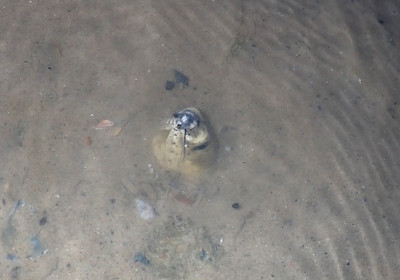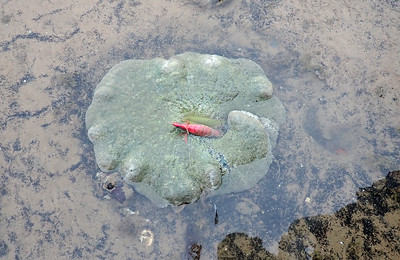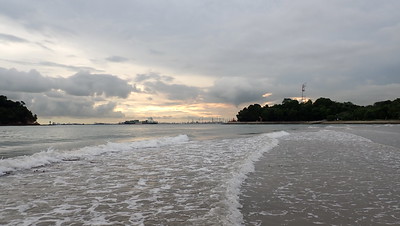The sandy area at the mouth of the Creek is still large and very much alive. We saw hints of Button snails and a large buried fish! Seagrasses remain lush and the small clump of Tape seagrass had regained long leaves! There was no sign of bleaching.
Sandy shores may look boring and dead, but they are interesting to me. Singapore has lost most of our sandy shores, so animals that live in such shores are less commonly seen. They are mostly buried, so you need to look for tell tale signs of their presence.
For example, I saw a few dead Button snail shells (taken over by tiny hermit crabs). I looked but couldn't find live ones. There were, however, many live Weasel olive snails on the sand bar, busily burrowing as night fell. They eat Button snails, so perhaps the Button snails are in deeper water? Sand bubbler crabs are common on sandy shores. Today, I spotted this pair that was clasped face-to-face in mating position and couldn't quite fit into their burrow. So cute!
The most amazing sandy shore sighting was by Darren, who spotted this fish buried in the sand with only the tip of its head above ground. Is it the Evermann's snake-eel? Snake-eels have tubular nostrils, and the Evermann's has a yellow chin. Sandy habitats are indeed fascinating!
There are slivers of rocky shore here. The rocks were covered with lots of snails. I saw many Lightning dove snails, Turban snails and Top shell snails, while well camouflaged Onch slugs crept about in cooler wetter spots.
Many colourful Nerite snails too. Under the stones, there was a Wandering cowrie. But the special mollusc find was by Arjun who spotted the Jewelled chiton in a crack in a rock. This chiton is listed as 'Endangered' in the Singapore Red List. I didn't see any signs of bleaching on the shore. There were still many Haddon's carpet anemones. I saw one Frilly sea anemone. And even one Pore hard coral. While the team saw Flowery soft corals growing in the big concrete cylinder that retains water at high tide. None of them were bleaching. Spoon seagrass (with tiny leaves) are still growing lush along the eastern bank of the Creek, closer to Keppel Club. Similar to what I saw in Feb 2020. Among the seagrasses were many tiny Orange-striped hermit crabs, tiny Swimming crabs and small fishes like a juvenile Brown sweetlips spotted by Darren. Seagrasses are indeed great nurseries for marine life that eventually move to deeper water as they grow up.
The patch of Tape seagrass has long leaf blades again! This is probably the first time I've seen a patch of Tape seagrass 'recover' from a cropped state. I hope this bodes well for the Tape seagrasses elsewhere which have been suffering from this cropped state for nearly 10 years.
Here's the patch in Feb 2020, when the leaf blades are cropped short. At that time, one of the rings of seagrass had three female flowers. Today, I didn't see any flowers. Although Tape seagrasses seen over the last few days elsewhere were blooming.
There were still blooms of Small coin green seaweed at the seawall area as well as in the eastern patch of seagrass. This was also observed in Nov 2018. Spoon seagrass was growing among them. Not sure if the seaweed allows the seagrass to settle or visa versa. Similar to what we saw in Feb 2020 and Nov 2018.
A Great billed heron was also hunting on the shore during our survey! Arjun took this photo of it. There was also a pair of Collared kingfishers loudly calling as they patrolled the shore.
The tide wasn't as low as predicted today, and turned at sunset. Hope it stays safe until we return to check up on it again.
Due to COVID rules, a separate group of volunteers surveyed Labrador at the same time. Thanks to NParks for permission to survey the shore. Special thanks to Darren and Pin Chong for looking after us and for taking care of these precious shores.
Others on the Berlayar survey
Arjun Sai Krishnan
Joleen Chan
Others on the Labrador survey
Richard Kuah
Vincent Choo
Parizad Nasheer
Other shores surveyed
Loh Kok Sheng was at Changi Carpark 7
Marcus Ng was at St John's Island














